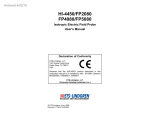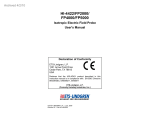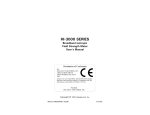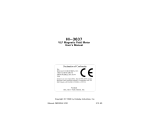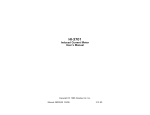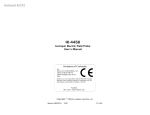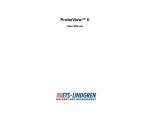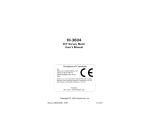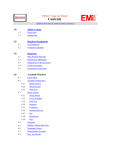Download HI-6005 Battery Service Bulletin - ETS
Transcript
HI-6005 Battery Service Bulletin READ THIS FIRST, THEN REFER TO THE HI-6005 USER MANUAL FOR FULL INSTRUCTIONS. Charge the Battery First: For maximum battery life it is important that you fully charge the battery of your HI-6005 Electric Field Probe before using it. Be sure the probe power switch is set to the OFF Position. Connect the charger to the electrical mains and connect the charger output to the HI-6005. Refer to the user manual for full details. Failing to fully charge the battery may result in reduced battery life and cause premature battery failure. Battery Shelf life: The NiMH battery powering the HI-6005 Electric Field Probe has a significant self-discharge characteristic. When the probe is stored for longer than a week or two, the battery will discharge even when not in use. For optimum testing time, it is advised to charge the battery before use. The battery charger provided with the HI-6005 is microprocessor controlled to charge the battery in the fastest possible manner. When the charger senses that the HI-6005 battery is fully charged, the charging current drops to a ‘maintenance’ level. This level is sufficient enough to maintain the battery fully charged without causing battery damage. When the charger is in maintenance mode it is acceptable to leave the probe connected to the charger for extended periods of time. If the period of non-use exceeds the two to three month window, a charge/discharge cycle should be performed. Following these procedures will assure maximum battery life and optimum testing performance. Synchronizing the Battery Charge Indicator: The HI-6005 Electric Field Probe has internal circuitry to track the charge condition of the battery. NiMH batteries have a sharp discharge-curve knee. This means that there is very little indication that the battery is nearly discharged prior to a “LOW BATTERY” condition. The internal circuitry tracks the charging and discharging currents of the battery and displays the calculated battery condition. It is possible that this battery charge indication may loose its synchronization with the actual battery condition. This may be indicated by a low battery charge indication when the battery has been recently fully charged. It may also be indicated by short battery life and premature LOW BATTERY indication. To synchronize the battery charge indicator, connect the battery charger to the electrical power mains and to the HI-6005 as described in the user manual. Be sure the power switch of the HI-6005 is in the OFF position. Press the DISCHARGE button the battery charger. The battery will now be fully discharged and then fully recharged. For best results repeat this process at least once more (total of two times). It may be necessary to Page 1 of 2 H-700105 repeat the process a total of three times for proper synchronization. The complete discharge/charge process may take up to 12 hours. When completely charged, the HI-6005 battery indicator should indicate a charge level more than 90%. USEFUL INFORMATION TO MAXIMIZE THE HI-6005 BATTERY LIFE: Your HI-6005 has a rechargeable nickel-metal hydride (NiMH) battery that must be properly maintained to ensure long life. With proper care, the HI-6005 battery should last from two to three years. Each HI-6005 probe contains a rechargeable nickel-metal hydride (NiMH) battery. A fully charged battery (nominal output voltage of 4.8 VDC) provides up to 10 hours of operation. When the battery has discharged to 4.4 VDC, the probe is still operational, but its battery needs charging. When the voltage drops below 4.0 VDC measurement accuracy may be compromised by continued operation. When the battery voltage indication is less than 4 volts, a “low battery” indication is attached to the output data string warning of the problem. Software packages from Holaday EMF Measurement/ETS-Lindgren provide a warning indication on the display screen of the readout device. It is recommended that custom software packages using data from the HI6005 Electric Field Probe monitor the data output for this condition. Although NiMH batteries are rated for operation in temperatures from –20o C to +65o C (4o F to +140o F), operating the probe in extreme temperatures will reduce operating time significantly. The optimum operating temperature range for these batteries is +20o C to +30o C (+68o F to +86o F). The battery in the HI-6005 does not require periodic “deep discharges” to reverse the capacity-depleating “memory effect” caused by repeated shallow discharges; however, undercharging can reduce battery capacity. Therefore, after the charging procedure is complete, be sure that the battery is fully charged before resuming field operation. If the battery exhibits low terminal voltages during charging, or if it appears unable to acquire or maintain an appreciable charge, individual cells in the battery may be shorted or damaged. If, for any reason, your battery needs replacement, contact ETS-Lindgren Customer Service for assistance. Page 2 of 2 H-700105


